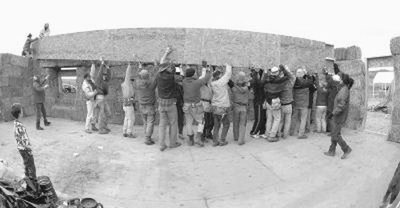July 11, 2002
Architecture prof and students using straw bales to build on Indian reservations
The winds of the Great Plains won’t stop two Montana tribes from making their newest buildings out of straw.
The two-week building blitz to begin July 14 on the Crow and Northern Cheyenne reservations — with 60 architecture and engineering students from both coasts among the volunteers — represents an ambitious step forward in the use of inexpensive straw as a remedy for the severe housing shortage on America’s Indian reservations.
Among the 2 million reservation residents, more than 300,000 suffer in overcrowded dwellings that lack insulation, plumbing or electricity, according to the American Indian Housing Initiative of the UW, Pennsylvania State University and Red Feather Development Group.
“If this housing crisis were happening in New York or Chicago, it would be all over the news,” said Robert Young, founder of Red Feather, based in Bellevue.
The initiative partners have spent five years developing a solution from straw, now a waste product discarded by the millions of tons. The faculty, students and volunteers turn bales of compressed straw plastered with stucco into cozy and durable homes that can be erected largely by nonprofessionals. The group has built three such homes, and on July 14 will send students from the two universities and other volunteers to help “blitz build” educational facilities at the two neighboring Montana reservations.
“These are our first public facilities, which will allow us to partner with the whole community,” said Sergio Palleroni, UW associate professor of architecture. “Everyone will have a stake in the project.”
“The initiative’s overriding goal is to promote self-sufficiency,” added architecture engineering professor David Riley, who heads the program at Penn State.
Dozens of tribes around the country are asking for similar training and technical support. Straw-bale homes are two-thirds the price of the manufactured homes now ubiquitous on reservations — and several times more energy-efficient.
Although the housing initiative has attracted such celebrity supporters as Oprah Winfrey and Robert Redford, only recently has straw become popular as an economical and eco-friendly building material. Talk of straw homes once provoked jokes about the Big Bad Wolf, but the material has endured years of real-world service as well as blowtorches, water jets and other intensive laboratory testing.
One such home built by the housing initiative in 1999 attracted the attention of four Crow middle school students, whose report documenting the sturdiness of straw-bale construction won the top prize in the Bayer/National Science Foundation Award: the $25,000 Columbus Foundation Community Grant. The four girls — who became collectively known as “The Rez Protectors” — decided to use their prize to build a much-needed study hall with the material. After conducting a ritual buffalo hunt, tribal members and the initiative volunteers will go to work July 14 on the 1,200-square-foot hall at Crow Agency.
Meanwhile, some 40 miles away at Chief Dull Knife Memorial College on the Northern Cheyenne Reservation, university students and Red Feather volunteers will help that tribe build a literacy center for adult and early-childhood reading development. Both projects are intended to help the initiative partners build strong relationships with the tribes and develop housing solutions as a team.
“It’s not just about putting up a single building,” Palleroni said. “It’s imagining a different future for these communities.”




